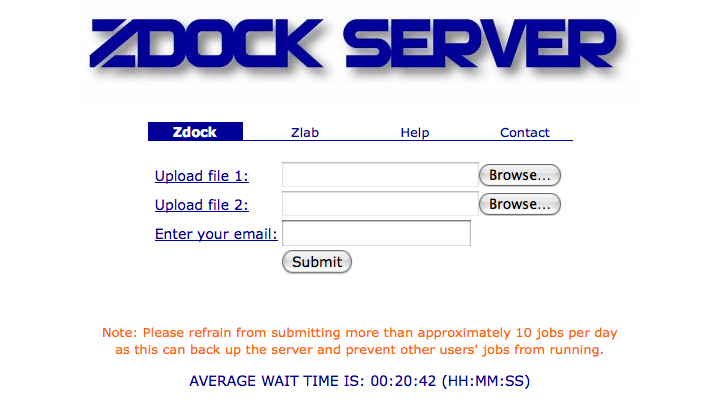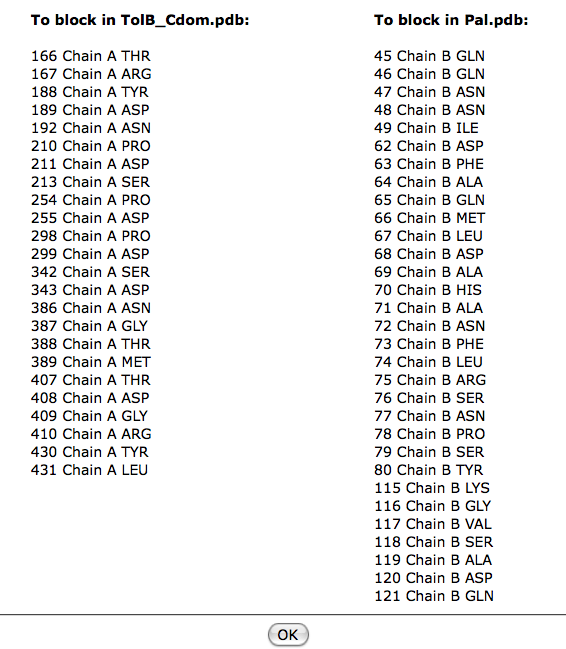
By Kevin Wiehe
This tutorial is intended to serve as a guide for docking two proteins with the ZDOCK server. In this tutorial we will dock the TolB/Pal complex, a target from CAPRI round 10, from its individual unbound component proteins. We will follow a docking protocol similar to what was used in our CAPRI paper. This will consist of 5 detailed steps and should take about 30 minutes to complete.
Table of Contents:
The first step is to get the structure files from the PDB for the proteins that we will be docking. For CAPRI Round 10, the PDB structure used for TolB was 1C5K Chain A and for Pal was 1OAP Chain A. You may prefer to download our pre-processed local copies: (TolB.pdb, Pal.pdb).
TolB has two domains, a small N-term domain, and a large beta-propeller C-terminal domain. From the biological literature, TolB is known to interact with Pal through its C-terminal domain (see our CAPRI paper for references). Before docking, it's best to remove the non-binding N-term domain, to decrease the possibility that our docking results would include this domain as part of the predicted interface. To do this, delete the ATOM lines of TolB.pdb that correspond to residues 35-166 . Or download the C-term domain only file here (TolB_Cdom.pdb).
Now it's time to visit the ZDOCK server webpage. The front page contains three fields: two upload fields and an email field. Notice that the average wait time of the last 20 jobs submitted to the server is displayed at the bottom of the page. This should give you a rough idea of how long your job will take to complete based on the past load in the queue. Expect your job to take longer if you are docking very large proteins.

Now go ahead and click the browse button to find the TolB PDB file you just downloaded, in order to upload it to the ZDOCK Server. Repeat this for the second upload field with the Pal PDB file. Place your email address in the email field and then press the submit button. Please note that you must use an academic email account as the ZDOCK Server is only available to academic users.
After hitting the submit button, you will be taken to the second page which allows you to choose residues to keep in or out of the binding site. In many cases in protein docking, there exists information in the biological literature that can be helpful in predicting the structure of the protein complex. Most of the time this comes in the form of mutagenesis data that can give the user an idea of which residues are important for binding and therefore are most likely located in the binding site. ZDOCK can use this information to focus the docking search (by blocking residues from the binding site) and/or by narrowing the list of top scoring predictions (through distance filters). Note that due to the way it is implemented in ZDOCK, blocking does not reduce the number of predictions returned (currently 2000), whereas designating residues to be in the binding site will almost certainly reduce the number of predictions returned.
Prior to the release of the complex structure, we had information from the biological literature that residues 246, 249 and 292 of TolB and a region of Pal that includes residues 89-130 are critical for binding. So for this example we will use that information to choose residues to block from and force into the binding site.
Blocking residues from the binding site usually involves identifying a handful of residues that are on the opposite side of where it is thought the interface of the complex is likely to be. Residues 246,249 and 292 of TolB are on the "top" of the beta-propeller domain, therefore we will select residues to block that are on the "bottom" of the domain to strongly discourage ZDOCK from making predicted complexes involving this face of the protein. In addition, we will block two residues at the N-terminus because this is where the domain that we removed would be in the full, biologically relevant structure of TolB.
Select the following residues for blocking on TolB: 166,167,188,189,192,210,211,213,254,255,298,299,342,343,386-389,407-410,430,431.
You may either select these from the scrolling menus in the middle of the page, or you can click on the first link at the bottom of the page for an easier way to select long lists of residues. For PalB, we will block residues opposite from the critical region of residues 89-130.
Select the following residues for blocking on Pal: 45-49,62-80,115-121.
Lastly, select residues 246, 249 and 292 of TolB to keep in the binding site. ZDOCK will only return results for predictions that have these TolB residues within 6 angstroms from Pal. This will significantly reduce the number of predictions that will be returned, as you will see shortly.
Note that if selecting patches of neighboring surface residues is desired, you can follow the second link at the bottom of the page entitled "For selecting residues within a distance threshold"
| Residues can be selected by the scroll-down menu: |
|
| Or residues can be selected by listing their numbers: |
|
After pressing the submit button, you will be asked to confirm your residue selections. For the TolB/Pal example, this will display the 3 residues in TolB selected to be in the binding site, as well as 24 residues and 31 residues to be blocked from TolB and Pal respectively:
|
 |
After you've selected the residues, hit the submit button to start the docking job. The next page will tell you that two emails are coming your way. The first will confirm that the job is submitted and the second will be your results. Please wait patiently for the second email and then proceed to the next step.
When your docking job completes, you will receive a second email that contains a link to the results page of your docking run. This page contains 4 links. The first three are download links for the ZDOCK output file, ligand file and receptor file. To automatically create the predicted complex files, download these three files into the same directory.
| The second email includes a link to your docking results page: |
|
Now click the fourth link, "Launch Create Complexes!" which is a Java program that will create the complexes for you. This should bring up a dialog box asking you to open or save the program. Choose "open". A second dialog box may appear asking if you wish to run the application without a digital signature. If you do not wish to proceed due to security concerns, then you will need to create the complexes manually. See here for instructions on how to do this. After proceeding, a new window will appear named "Create Complexes":
|
In the Create Complexes window, click the "ZDOCK Output File ..." button to browse for the ZDOCK output file you downloaded earlier. You now have two choices: You can either create all of the complexes or a subset of them. If you wish to create a subset, you will need to specify the start and end number for the subset in the two fields on the left and then click the "Create Subset" button. In our TolB/Pal example, ZDOCK will only return 99 complexes because we restricted predictions to include the TolB residues 246, 249 and 292 in the binding site. Since 99 complexes is a manageable number, go ahead and click the "Create All" button. Note that if we had not selected any residues from the "Force residues into binding site" menu, then "Create All" would return all 2000 predicted complexes, which may take a few minutes to complete and can require several hundreds of megabytes of space to store the files.
Now that you have complexes created, you can compare them to the solved complex structure (PDB: 2HQS, or our local pre-processed copy: TolBPal_complex.pdb) . You should see that 4 of the top 10 predictions are acceptable predictions under the CAPRI rating system. As well, the 69th ranked predicted complex achieves the "medium" accuracy level.
Congratulations! You've completed the tutorial for docking the TolB/Pal complex.